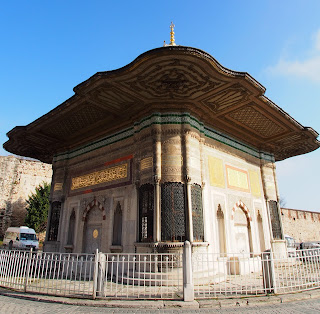Ottoman Fountains in Istanbul - Culture for free
Yet still the best way to experience Istanbul is by foot. Not only due to traffic and the partial closeness of sights, especially because literally around every corner there is something to see or to experience. One of these things in Istanbul are the Ottoman Fountains. For sure everyone visiting Istanbul will pass some of them, at least on the way from one famous sight to another. But they are often to beautiful and interesting to be just passed by. Therefore here some information about the Ottoman Fountains in Istanbul, which apparently are free to see, visit and touch.
In Ottoman Istanbul fountains were often built with mosques, providing the part of the religious ritual of cleansing before and after prayer. But as often they were used for distribution of water to the public, usually as a charity. These architectural artworks show an almost forgotten part of the rich Turkish culture and history.
The most important fountains in İstanbul that have been restored are the Ahmed III Fountain, which is situated at the Imperial Gate of Topkapi Palace, the Tophane Fountain of Mahmud I (1732), the Saliha Sultan Fountain in Azapkapı (1732), the Göksu Fountain in Üsküdar (1728), the İshak Ağa Fountain in Beykoz (1749), the Vezir Hekimoğlu Ali Paşa Fountain in Kabataş (1732), the Abdülhamid II Fountain in Maçka (1901) and the Hamidiye Fountain in Galatasaray (1906).
The oldest known fountains in İstanbul are the Davutpaşa Fountain (1559-1560) and the Şahruh Fountain in Fatih (1559-1560).
Çesme (Persian)
A structure from which water is made to flow in an orderly way for everybody’s benefit.
Fiskiye (Arabic)
The mouth of a pool that shoots water upward in various designs.
Sebil (Arabic, Road)
It is said of places that always distribute drinking water in acceptance of God’s will. These places are usually found next to mosques and each has a distinctive style.
Sadirvan (Persian, Sad - much; irvan – it flows)
A sadirvan is a pool into which abundant water splashes from a rather higher point or is a water reservoir that is surrounded by a wall that has faucets. They are usually found in mosque courtyards where they are used for ablutions before prayer service. They may be covered or open.
Şelale (Arabic, Waterfall)
In Ottoman times, it was often an artificial waterfall created to resemble those occurring naturally.
One of the prime examples of public fountains in Istanbul is the German Fountain, the Alman Çeşmesi. Located at the northern tip of the old hippodrome, an area full of ancient monuments which is always worth a visit. Not being an Ottoman fountain, but a built in the neo-Renaissance style, it is nevertheless worth visiting.
Important Ottoman Fountains in Istanbul
 |
| Ahmed III Fountain, Ottoman Fountain, Istanbul |
The most important fountains in İstanbul that have been restored are the Ahmed III Fountain, which is situated at the Imperial Gate of Topkapi Palace, the Tophane Fountain of Mahmud I (1732), the Saliha Sultan Fountain in Azapkapı (1732), the Göksu Fountain in Üsküdar (1728), the İshak Ağa Fountain in Beykoz (1749), the Vezir Hekimoğlu Ali Paşa Fountain in Kabataş (1732), the Abdülhamid II Fountain in Maçka (1901) and the Hamidiye Fountain in Galatasaray (1906).
The oldest known fountains in İstanbul are the Davutpaşa Fountain (1559-1560) and the Şahruh Fountain in Fatih (1559-1560).
Types of Ottoman Fountains
The types of the Ottoman Foutains in Istanbul vary from place to place and according to who built them when. Nevertheless there are five types of fountains which are the most common ones in Istanbul, namely cesme, fiskiye, sebil, sadirvan, selale. |
| Inscription at the Ahmed III Ottoman Fountain, Istanbul |
Çesme (Persian)
A structure from which water is made to flow in an orderly way for everybody’s benefit.
Fiskiye (Arabic)
The mouth of a pool that shoots water upward in various designs.
Sebil (Arabic, Road)
It is said of places that always distribute drinking water in acceptance of God’s will. These places are usually found next to mosques and each has a distinctive style.
Sadirvan (Persian, Sad - much; irvan – it flows)
A sadirvan is a pool into which abundant water splashes from a rather higher point or is a water reservoir that is surrounded by a wall that has faucets. They are usually found in mosque courtyards where they are used for ablutions before prayer service. They may be covered or open.
Şelale (Arabic, Waterfall)
In Ottoman times, it was often an artificial waterfall created to resemble those occurring naturally.
Special: The German Fountain
 |
| German Fountain, Istanbul - Picture and location |


Comments
Post a Comment